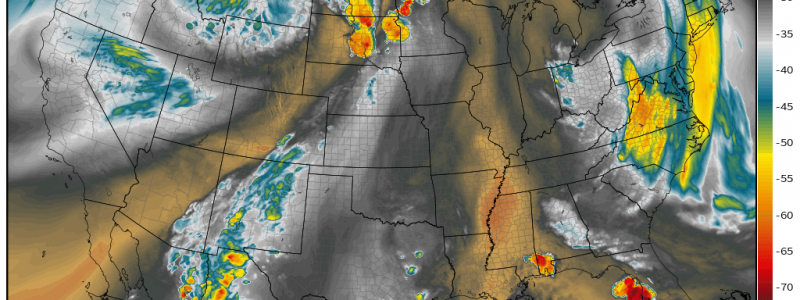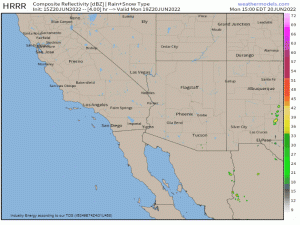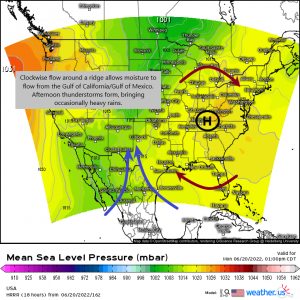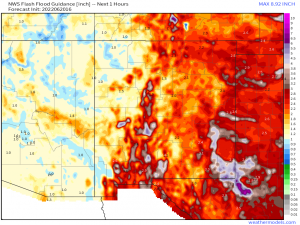
Explaining the Monsoon
If you’re a frequent checker of the SPC outlooks, you may have noticed the general thunderstorm category extends just a little further south and west than is usual. In fact, it extends into the desert southwest – areas like New Mexico and Arizona.
Despite what many think, rain really isn’t that uncommon in this area, specifically at this time of year.
The period of time between June 15 and September 30 is what is known as Monsoon Season. The word “monsoon” is often used wrong. People use it to indicate heavy rains when in fact the true definition is a change or reversal of the winds.
Generally, the US is under the influence of a westerly flow. This allows very little moisture to make it into the desert southwest.
In the summer, however, the jet stream lifts north and long-lived ridging is allowed to build in over the Eastern US. The clockwise flow around the ridge allows winds to flow from the Gulf of Mexico in to the southeast or from the Gulf of California in the southwest. This flow brings moisture into the desert southwest.
Daytime heating then allows for thunderstorms to form, reminiscent of a hot summer day in the southeast. These thunderstorms are capable of heavy rain, assuming enough moisture is available, and can lead to flash flooding.
As you can see, it doesn’t take much rainfall to exceed Flash Flood values in this region. Burn scars, mountainous areas, and low-lying terrain (such as canyons) are particularly vulnerable to flash flooding woes.
Monsoon season isn’t a sure thing. It is highly dependent on these ridges forming and lingering in the eastern half of the US. No ridge, no beneficial flow.
Monsoons also aren’t exclusive to the southwest US, either. They occur near the tropics as the ITCZ (Intertropical Convergence Zone) moves north in the summertime. The most well-known monsoon season occurs in India and South Asia. This monsoon can be particularly strong as the Himalayas block dry air from invading the region, allowing moisture to reign supreme. The Sahel region just south of the Sahara Desert in Africa also experiences a monsoon as does Panama, Costa Rica, Nicaragua, and western Mexico.
Global circulations such as El Nino and La Nina influence the amount of rain that falls during these events. Typically, a La Nina pattern means a wetter monsoon. However, this is not always the case as many other factors come into play as well.
The Monsoon is very important to the economy of these regions. Without that summer rainfall, crops will fail and water reserves won’t be replenished to last through the dry months. On the other hand, too much rainfall can also cause crops to fail and flash flooding has consequences of its own.
Hopefully you enjoyed this little piece on a rather important part of our yearly weather cycles, and perhaps you learned something, too!















I lived in Tucson for 37 years. You can smell the first day of humidity; it is that dramatic. Dew points averaging 54 F. for 3 consecutive days have been the classic definition of the start, although it is now a calendar one. Humidity is seldom above 60% because of the hot temperatures. Dew Point depressions in early June can be more than 100 degrees F.! You look for 500 mb winds out of the south, SE, or east, but you also need moist air in those places. Tucson is on the northern fringes of the monsoon. Sometimes, there are haboobs that can move literally hundreds of miles up I-10 to the west. While it is a 4 corners high that usually captures the moisture, a high NW of AZ, in Nevada, can bring storms up along the Mogollon (mug E yon) Rim with a classic cloudiness from NW to SE along the rim, seen on satellite images in summer. Arizona ranks high among the states for days with thunderstorms. You look at the PW, Total Totals, the LI, whether or not there is a cap, and a host of other things. It can be a huge disappointment in a bad year. In a good year, the lightning shows in the desert are incredible. I live in Oregon now, where sometimes the monsoonal moisture reaches to produce lightning on very dry forests, since the summer months up here are the driest.
Good stuff. I look forward to more wx schooling!